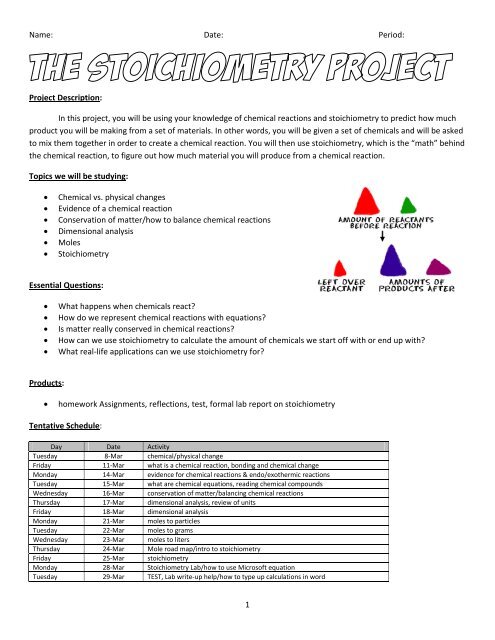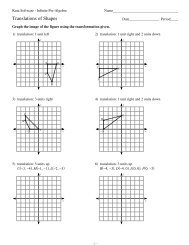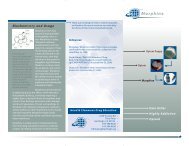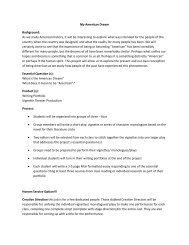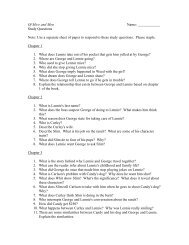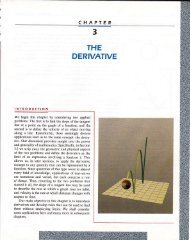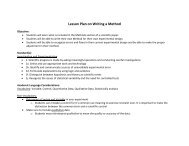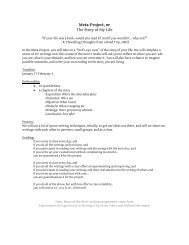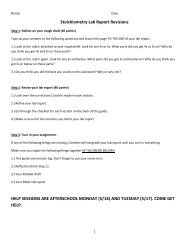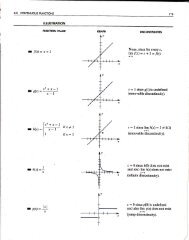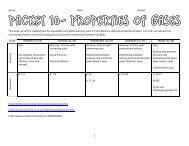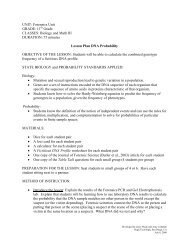1 Name: Date: Period: Project Description: In this project, you will be ...
1 Name: Date: Period: Project Description: In this project, you will be ...
1 Name: Date: Period: Project Description: In this project, you will be ...
You also want an ePaper? Increase the reach of your titles
YUMPU automatically turns print PDFs into web optimized ePapers that Google loves.
Chemical Changes on a Molecular LevelLet’s look at the chemical reaction of magnesium and oxygen.http://www.<strong>you</strong>tu<strong>be</strong>.com/watch?v=m2i9jLPXprQDescri<strong>be</strong> what magnesium ribbon looks like:Descri<strong>be</strong> what oxygen looks like:Descri<strong>be</strong> what magnesium oxide (MgO) looks like:Let’s look at the chemical equation for the reaction:2 Mg (s) + O 2 (g) ----> 2 MgO(s)On a molecular level, chemical changes occur when….3
Homework4
Mostly Cloudy Mini-Lab1.) Put on googles.2.) La<strong>be</strong>l 1 plastic cup “water” and 1 plastic cup “limewater.”3.) Measure out 5 mL of water and pour it into the cup la<strong>be</strong>led “water.”4.) Measure out 5 mL of limewater and pour it into the cup la<strong>be</strong>led “limewater.”5.) Add 5 mL of carbonated water into each cup. Observe what happens.Fill out <strong>this</strong> data table:MaterialsWater + carbonated waterObservationsLimewater + carbonated waterJournal: <strong>In</strong> which cup did <strong>you</strong> think a chemical reaction occurred? What evidence supports <strong>you</strong>r conclusion?7
HomeworkStoichiometry Reflection #2Please type up <strong>you</strong>r answers using size 12, Times New Roman, double-spaced font. You should <strong>be</strong> thorough andcomplete in answering all of these questions. Please email me <strong>you</strong>r answers when <strong>you</strong> are done.1.) What experiments or reactions did <strong>you</strong> like doing today in class? Why?2.) What are some ways to tell if a chemical reaction or change has happened?3.) What lessons did <strong>you</strong> learn from the “Mostly Cloudly Mini-Lab?” Which chemicals had a reaction? Which chemicalsdid not? How do <strong>you</strong> know?4.) Look at the following pictures and explain how <strong>you</strong> know a chemical reaction occurred for each picture:Picture #1: Picture #2:
STEP 3: EVIDENCE FOR CHEMICAL REACTIONS (EXO & ENDOTHERMIC REACTIONS)Journal: We’ve already learned a couple of ways to identify whether a chemical reaction has occurred or not. What aresome signs that show us whether a chemical reaction has occurred or not?One more way to see whether a chemical reaction has occurred or not is from ________________________________***NOTE: every chemical reaction needs some energy to get started. We call <strong>this</strong> energy the ____________________.Picture APicture BThere are 2 types of reactions:Some reactions __________________________ while others ______________________________________________.1.2.9
Evidence For Chemical Reactions LabAdapted from http://www.middleschoolscience.com/bag.htmObjective: <strong>In</strong> <strong>this</strong> lab, <strong>you</strong> <strong>will</strong> <strong>be</strong> observing a couple of chemical reactions andfinding ways to descri<strong>be</strong> how <strong>you</strong> know chemical reactions have actuallyoccurred.Materials: sandwich size zip top bag (x3) 2 plastic spoons 2 tbsp calcium chloride (x3) 2 Tbsp. baking soda (x3)1 test tu<strong>be</strong> of water (x3)30 mL of phenolphthalein (x3)Goggles, gloves, lab apronProcedure Bag 1:1. Place 2 tsp of baking soda into the bag.2. Add 30 mL of Phenolphthalein to the bag.3. Massage the bag to mix the contents.4. VERY CAREFULLY - lower the test tu<strong>be</strong> containing 30 mL of water upright into the bag. Do not let any spill out.5. One group mem<strong>be</strong>r should hold the test tu<strong>be</strong> by squeezing the test tu<strong>be</strong> gently from the outside of the bagwhile another group mem<strong>be</strong>r squeezes the excess air out and seals the bag.6. Hold the test tu<strong>be</strong> and bag up and slowly spill the water out of the test tu<strong>be</strong> (while the bag is still sealed).Observe the reaction and record what <strong>you</strong> see and feel happening in the data section.7. Pass the bag around and let all group mem<strong>be</strong>rs look at and feel the contents of the bag.Procedure Bag 2:1. Place 2 tsp of calcium chloride into the bag.2. Add 30 mL of Phenolphthalein to the bag.3. Massage the bag to mix the contents.4. VERY CAREFULLY - lower the test tu<strong>be</strong> containing 30 mL of water upright into the bag. Do not let any spill out.5. One group mem<strong>be</strong>r should hold the test tu<strong>be</strong> by squeezing the test tu<strong>be</strong> gently from the outside of the bagwhile another group mem<strong>be</strong>r squeezes the excess air out and seals the bag.6. Hold the test tu<strong>be</strong> and bag up and slowly spill the water out of the test tu<strong>be</strong> (while the bag is still sealed).Observe the reaction and record what <strong>you</strong> see and feel happening in the data section.7. Pass the bag around and let all group mem<strong>be</strong>rs look at and feel the contents of the bag.Procedure Bag 3:1. Place 2 tsp of baking soda into the bag.2. Place 2 tsp of calcium chloride.3. Add 30 mL of Phenolphthalein .4. Massage the bag to mix the contents.5. VERY CAREFULLY - lower the test tu<strong>be</strong> containing 30 mL of water upright into the bag. Do not let any spill out.6. One group mem<strong>be</strong>r should hold the test tu<strong>be</strong> by squeezing the test tu<strong>be</strong> gently from the outside of the bagwhile another group mem<strong>be</strong>r squeezes the excess air out and seals the bag.7. Hold the test tu<strong>be</strong> and bag up and slowly spill the water out of the test tu<strong>be</strong> (while the bag is still sealed).Observe the reaction and record what <strong>you</strong> see and feel happening in the data section.8. Pass the bag around and let all group mem<strong>be</strong>rs look at and feel the contents of the bag.10
*****AS PART OF YOUR HOMEWORK, PLEASE EMAIL ME YOUR DATA & OBSERVATIONS SECTION AND THECONCLUSION SECTION.Data & ObservationsFill out the following table for the chemical reaction that <strong>you</strong> saw happening in each bag.Bag #1What happened withthe color?Werefoam/bubbles/gasproduced?Was there atemperature change?Did it get hotter orcolder or stay thesame?Was <strong>this</strong> reactionendothermic,exothermic orneither?Bag #2Bag #3ConclusionAnswer the following questions. Please <strong>be</strong> specific and answer each question completely!1.) <strong>In</strong> terms of color change, how were the 3 bags similar? How were they different?2.) <strong>In</strong> terms of foam/bubbles/gas <strong>be</strong>ing produced, how were the 3 bags similar? How were they different?3.) <strong>In</strong> terms of temperature change, how were the 3 bags similar? How were they different?4.) Did a chemical reaction happen in Bag #1? How can <strong>you</strong> tell?5.) Did a chemical reaction happen in Bag #2? How can <strong>you</strong> tell?6.) Did a chemical reaction happen in Bag #3? How can <strong>you</strong> tell?7.) Without opening the bags, how can <strong>you</strong> tell if a gas was produced or not?8.) The reaction in the 3 rd bag was:2NaHCO 3 + CaCl 2 -----------> CaCO 3 + 2NaCl + H 2 O + CO 2baking soda + calcium chloride calcium carbonateA.) Using <strong>this</strong> chemical equation, summarize what materials we started off with in <strong>this</strong> reaction and what materials weended up producing. For example, “We took baking soda (NaHCO 3 ) and mixed it with calcium chloride. They reacted andformed calcium carbonate…..” ---> so finish <strong>this</strong> sentence….THERE IS MORE ON THE NEXT PAGE – FLIP OVER!11
B.) Using the chemical equation above, what gas was produced in Bag #3?9.) Which reactions in <strong>this</strong> lab were exothermic? How do <strong>you</strong> know that they were exothermic?10.) Which reactions in <strong>this</strong> lab were endothermic? How do <strong>you</strong> know that they were endothermic?QUESTIONS ON ENERGY GRAPHS FOR CHEMICAL REACTIONSAdapted from http://www.kentchemistry.com/links/Kinetics/PEDiagrams.htm11.) What is activation energy?12.)Given the reaction: A + B --> C. Does the diagram show an endothermic or exothermic reaction? Why or why not?13.) The reaction that forms water is <strong>be</strong>low:2 H 2 (g) + O 2 (g) --> 2 H 2 O(l) + 571.6 kJ<strong>In</strong> <strong>this</strong> reaction, one of the products is heat, meaning, heat is released in <strong>this</strong>reaction.a.) Is <strong>this</strong> reaction endothermic or exothermic? Why or why not?b.) Which graph (to the right) is the correct graph to represent the reactionthat forms water? Why did <strong>you</strong> pick that graph?14.) The diagram <strong>be</strong>low represents a chemical reaction. Use <strong>this</strong> diagram toanswer the following questions.a.) Is <strong>this</strong> reaction an endothermic or exothermic reaction? Howdo <strong>you</strong> know?b.) Which letter represents the activation energy? How do <strong>you</strong>know?c.) Using the letters in the diagram (i.e. A, B, C, or D) whatformula would <strong>you</strong> use to figure out the difference <strong>be</strong>tween theenergy of the reactants and the energy of the reactants?d.) Using the letters in the diagram (i.e. A, B, C, or D) whatformula would <strong>you</strong> use to figure out the amount of activationenergy needed to start the reaction?12
15.) The diagram <strong>be</strong>low represents a chemical reaction. Use the diagram to answer the following questions.a.) How much is the activation energy for <strong>this</strong> reaction? How did <strong>you</strong>find <strong>you</strong>r answer?b.) What is the difference in energy <strong>be</strong>tween the reactants and theproducts? How did <strong>you</strong> find <strong>you</strong>r answer?c.) Is <strong>this</strong> reaction endothermic or exothermic? How do <strong>you</strong> know?13
STEP 4: WHAT ARE CHEMICAL EQUATIONS?Journal: When <strong>you</strong> text, what are some abbreviations <strong>you</strong> use? What do these abbreviations mean?Chemical Equations are….FormulasWhat do these formulas mean? How many atoms are in each compound?EX:CaCO 3EX:10 CO 2TRY THESE OUT:Formulas1. ) N 2How many molecules(units) are there?Elements/# of atoms per element2.) BaCO 33.) CH 3 COOH4.) H 2 SO 45.) (NO 3 ) 26.) (OH) 37.) (SO 4 ) 38.) Fe 2 (CO 3 ) 39.) (NH 4 ) 3 PO 410.) 2 H 2 O11.) 3 V 2 O 512.) 3 B(OH) 313.) 5 B 2 (SO 4 ) 314.) 2 Be(NO 2 ) 215.) 7 Cu(OH) 214
Structure of an EquationAll chemical reactions follow the same structure.There are 2 main parts:1.2.The general structure is….***NOTE:Dollar Bill Demonstration2 C 3 H 7 OH + 6 O 2 ------> 6 CO 2 + 2 H 2 OReactantsHow many molecules(units) are there?Elements/# of atoms per elementProducts15
Homework1.) What are reactants?2.) What are products?3.) The following chemical reaction is photosynthesis, or the process by which plants make food (sugars). Fill out thetable <strong>be</strong>low based on <strong>this</strong> chemical reaction.ReactantsHow many molecules(units) are there?Elements/# of atoms per elementProducts16
4.) Fill out the following table based on the chemical formula.Formulas How many molecules(units) are there?Elements/# of atoms per element1. ) C 2 H 4 O 22.) Na 2 O3.) Fe(NO 3 ) 24.) Be(NO 2 ) 25.) Ga 2 (SO 3 ) 36.) 2 NaNO 37.) 4 Li 2 SO 48.) 3 Pb(NO 3 ) 29.) 10 Al 2 (SO 4 ) 317
STEP 5: CONSERVATION OF MASSReview- How many molecules and elements do I have?Formulas How many molecules(units) are there?Elements/# of atoms per element1. ) Fe 2 (SO 4 ) 32.) 3 CH 43.) 3 H 2 (SO 4 )Discover Activity with the coins1.) Sort stacks into pennies, nickels, dimes and quarters. Fill out the table <strong>be</strong>low.coins Pennies Nickels Dimes Quarters TOTAL $amount2.) Now mix them together and make 3 random stacks of these coins. Fill out the table <strong>be</strong>low.coins Pennies Nickels Dimes Quarters TOTAL $amount3.) Mix the coins together again and now stack them into 4 random stacks.coins Pennies Nickels Dimes Quarters TOTAL $amountDescri<strong>be</strong>d what happened in <strong>this</strong> activity. Did the num<strong>be</strong>r of pennies, nickels, dimes and quarters change? Did the totalamount of money change? Why or why not?Conservation of MassWhat did <strong>you</strong> noticehappening in <strong>this</strong> picture andwith <strong>this</strong> chemical reaction?The principle of conservation of mass states that in a chemical reaction….18
Balancing Chemical EquationsBecause of the principle of conservation of mass, there must <strong>be</strong> …..**THEREFORE, a chemical equation MUST <strong>be</strong>….STEPS TO BALANCING CHEMICAL EQUATIONS…1.) Write the equation2.) Count the atoms3.) Use the coefficients (num<strong>be</strong>rs in front) to balance the atoms4.) Look back and checkPractice1.)19
2.)3.)4.) Methane gas (CH 4 ) reacts with chlorine gas (Cl 2 ) to form chloroform (CHCl 3 ) and hydrochloric acid (HCl). Balance <strong>this</strong>equation.5.) Balance the following equation:___Fe + ___ H 2 (SO 4 ) -------> _____Fe 2 (SO 4 ) 3 + ____H 220
HomeworkFor each problem, balance the chemical equation if needed. If the equation is already balanced, <strong>you</strong> can just write“equation already balanced.”***Hint: Substitute (NO 3 ) with X21
If <strong>you</strong> want to check <strong>you</strong>r answers or need help on # 7 – check out <strong>this</strong> video:http://www.khanacademy.org/video/balancing-chemical-equations?playlist=Chemistry7.)_____Al + _____O 2 ------> _____Al 2 O 38.)_____C 2 H 4 + _____O 2 ------> _____CO 2 + _____H 2 O9.)_____C 2 H 4 + _____O 2 ------> _____CO 2 + _____H 2 O10.)_____C 2 H 6 + _____O 2 ------> _____CO 2 + _____H 2 O11.)_____Fe 2 O 3 + _____H 2 SO 4 ------> _____Fe 2 (SO 4 ) 3 + _____H 2 O22
STEP 6: DIMENSIONAL ANALYSIS PART 1How many seconds are in a year? __________________________Dimensional analysis is a method that is used to _______________________________________________________STEPS TO DIMENSIONAL ANALYSISEX #1 : How many seconds are in day?1.) What are <strong>you</strong> trying to figure out? What units do <strong>you</strong> want <strong>you</strong>r answer in?2.) What do <strong>you</strong> know? (Write down any conversion factors <strong>you</strong> know).3.) Pick a starting factor4.) Solve – make sure <strong>you</strong> end with the units <strong>you</strong> are looking for. Cross off/cancel any units. Multiply across the top andmultiple across the bottom. Then divide.5.) Ask <strong>you</strong>rself if <strong>you</strong>r answer makes senseEX #2 : How many hours are in year?1.) What are <strong>you</strong> trying to figure out? What units do <strong>you</strong> want <strong>you</strong>r answer in?2.) What do <strong>you</strong> know? (Write down any conversion factors <strong>you</strong> know).23
3.) Pick a starting factor4.) Solve – make sure <strong>you</strong> end with the units <strong>you</strong> are looking for. Cross off/cancel any units. Multiply across the top andmultiple across the bottom. Then divide.5.) Ask <strong>you</strong>rself if <strong>you</strong>r answer makes senseEx #3: If <strong>you</strong> are going 50 miles per hour, how many feet per second are <strong>you</strong> traveling?1.) What are <strong>you</strong> trying to figure out? What units do <strong>you</strong> want <strong>you</strong>r answer in?2.) What do <strong>you</strong> know? (Write down any conversion factors <strong>you</strong> know).3.) Pick a starting factor4.) Solve – make sure <strong>you</strong> end with the units <strong>you</strong> are looking for. Cross off/cancel any units. Multiply across the top andmultiple across the bottom. Then divide.5.) Ask <strong>you</strong>rself if <strong>you</strong>r answer makes sense24
EX #4: How many seconds are in a year?1.) What are <strong>you</strong> trying to figure out? What units do <strong>you</strong> want <strong>you</strong>r answer in?2.) What do <strong>you</strong> know? (Write down any conversion factors <strong>you</strong> know).3.) Pick a starting factor4.) Solve – make sure <strong>you</strong> end with the units <strong>you</strong> are looking for. Cross off/cancel any units. Multiply across the top andmultiple across the bottom. Then divide.5.) Ask <strong>you</strong>rself if <strong>you</strong>r answer makes senseEX #5 You're throwing a pizza party for 15 and figure each person might eat 4 slices. How much is the pizza going tocost <strong>you</strong>? You call up the pizza place and learn that each pizza <strong>will</strong> cost <strong>you</strong> $14.78 and <strong>will</strong> <strong>be</strong> cut into 12 slices. Youtell them <strong>you</strong>'ll call back. Do <strong>you</strong> have enough money? Here's how <strong>you</strong> figure it out, step by step.25
Homework26
1.) How many nickels are in 10 dimes?DIMENSIONAL ANALYSIS PRACTICE DAY 12.) How many dimes are in 5 dollars?3.) How many quarters are in 10 dollars?4.) How many pennies are in 52 nickels?5.) How many dimes are in 20 quarters?27
For the following problems, use the conversion factors.6.) How many miles <strong>will</strong> a person run during a 10 kilometer race?Conversions Factors1 hr = 60 min 7 days = 1 week24 hrs = 1 day 264.2 gal = 1 cubic meter1 mi = 5,280 ft 20 drops = 1 mL365 days = 1 year 1 L = 1000 mL0.625 mi = 1.00 km 1 L = 1000 cc7.) The moon is 250,000 miles away. How many feet is it from the earth?8.) A family pool holds 10,000 gallons of water. How many cubic meters is <strong>this</strong>?9.) The average HTHCV student is in class 330 minutes per day. How many hour per day is <strong>this</strong>? How many seconds is<strong>this</strong>?10.) Pepsi puts 355 ml of pop in a can. How many drops is <strong>this</strong>? How many cubic meters is <strong>this</strong>?11.) Change 60 miles/ hour to _____ft/sec (clue: both miles and hour must <strong>be</strong> change to other units)12.) How many seconds are in a year?28
STEP 7: DIMENSIONAL ANALYSIS PART 2Class Practice1.) Jason Biehl raised 60 goats, and then entered into a series of business transactions. He traded all the goats for sheepat an exchange rate of 5 goats for 7 sheep. Next, he exchanged all the sheep for hogs at a rate of 4 sheep for 2 hogsweighing 250 lbs. each. He sold all the hogs at a market price of $55.00 per 100.0 lbs. How much money did he makefrom the 60 goats?2.) How many miles could <strong>you</strong> drive for $7.90 if the gas mileage of <strong>you</strong>r car is 14 km/liter of gas and the price is$1.29/gal? (1.61 km/mile, 4 qt/gal, 1.1 qt/L)1. Convert the following.a. 0.044 km to metersb. 0.107 g to centigramsc. 15 cm3 to liters1 km = 1000 m1 m = 10 dm1 m = 100 cm1 m = 1000 mm1 m = 10 6 m1 m = 10 9 nm(for meters, grams, andLiters)d. 7.38 g to kilogramse. 6.7 seconds to milliseconds29
2. Convert 112 nm to km.3. What is 10 Kg/mL in units of g/L?4. How many minutes are there in exactly one week?5. How many seconds are in exactly a 40-hr work week?6. Convert 8 hours to seconds.7. An experiment requires that each student use an 8.5 cm length of magnesium ribbon. How many students can do theexperiment if there is a 570cm length of magnesium ribbon available?8. A 1.00 degree increase on the Celcius scale is equivalent to a 1.80 degree increase on the Fahrenheit scale. If atemperature increases by 48.0 °C, what is the corresponding temperature increase on the Fahrenheit scale?9. A chicken needs to <strong>be</strong> cooked 20 minutes for each pound it weighs. How long should the chicken <strong>be</strong> cooked if itweighs 4.5 pounds?10. You have a cu<strong>be</strong> with a density of 4.00 g/mL. How much volume would that cu<strong>be</strong> occupy, if it has a mass of 25 g?11. The speed of light is 3.0 x 10 8 m/s. How far could light travel in 6 minutes?30
STEP 8: MOLES & PARTICLESReview: Balance the following equation and write in a complete sentence what <strong>this</strong> chemical equation is saying._____ CuO + ____C -----> ____ Cu + ____CO 2<strong>Description</strong> of what <strong>this</strong> chemical equation is saying:(HINT: CuO = copper oxide)*Unfortunately, <strong>this</strong> interpretation contains such small quantities of material, so small that <strong>you</strong> wouldn’t <strong>be</strong> able tosee the reaction. Scientists came up with a new counting unit called the MOLE1 MOLE (mol) = particles( )Converting From Moles to ParticlesEX: How many gummy <strong>be</strong>ars are 2 mols of gummi <strong>be</strong>ars?EX: How many M&Ms are 5 mols of M&Ms?EX: How many molecules is 2.12 moles of C 3 H 8 (propane)?Converting From Particles to MolesEX: There are approximately 2.43 x 10 46 molecules of water in the Pacific Ocean. How many moles of water is <strong>this</strong>?EX: The average American drinks 6,000 sodas a year. How many moles of soda is <strong>this</strong>?EX: How many moles of magnesium is 3.01 x 10 22 atoms of magnesium?31
HomeworkConverting Particles to Moles and Moles to ParticlesMole-Particle Conversions1. How many moles of magnesium is 3.01 x 10 22 atoms of magnesium?2. How many molecules are there in 4.00 moles of glucose, C 6 H 12 O 6 ?3. How many moles are 1.20 x 10 25 atoms of phosphorous?4. How many atoms are in 0.750 moles of zinc?5. How many molecules are in 0.400 moles of N 2 O 5 ?32
STEP 9: MOLES & GRAMSReview:1.) How many molecules are there in 4.0 moles of H 2 O 2 ?2.) Change 7.14 x 10 23 molecules to moles**<strong>In</strong> a lab, it is too difficult to count out 6.02 x 10 23 particles of a substance every time <strong>you</strong> want to measure out amole. <strong>In</strong>stead, <strong>you</strong> can quickly figure out a mole of a substance by finding its molar mass (or how much 1 mole of asubstance weighs).1 MOLE (mol) =Molar Mass =Finding the Molar Mass of Elements & Compounds1.) C2.) Cu3.) CO 24.) Cu 2 CO 3 (OH) 2Converting Moles to Grams1.) How many grams are 2 moles of oxygen?2.) How many grams are 3.5 moles of water?34
3.) How many grams is 2.4 moles of vinegar (CH 3 COOH)?4.) How many grams is 0.6 moles of salt (NaCl)?Converting Grams to Moles1.) How many moles are in 28 grams of CO 2 ?2.) Find the num<strong>be</strong>r of moles of argon in 452 g of argon.3.) Find the grams in 1.26 x 10 -4 mol of HC 2 H 3 O 2.35
HOMEWORKMolar MassDo the following practice problems <strong>be</strong>low.36
STEP 10: MOLES & LITERS (FOR GASES ONLY!!)Review:1.) How many moles is 23 grams of H 2 O?2.) How many grams is 2.5 moles of glucose (C 6 H 12 O 6 )?Mole-Volume RelationshipAvogadro’s hypothesis:Reason for <strong>this</strong> is….1 MOLE (mol) = liters = particlesWhat <strong>this</strong> means is….***NOTE: This conversion only applies to gases at standard temperature and pressure(STP) which is…Moles to Volume Conversion1.) Determine the volume, in liters, of 0.60 mol of SO 2 gas at STP.2.) What is the volume of 3.20 x 10 -3 moles of CO 2 at STP.38
3.) At STP, what volume does 0.355 moles of C 2 H 6 occupy or take up?Volume to Moles Conversion1.) How many moles does 44.8 L of Hydrogen gas at STP represent?2.) A sample of oxygen gas occupies 6.2 L at STP. How many moles does that represent?3.) How many moles of neon would occupy 450 mL at STP? (1000 mL = 1 L)39
HomeworkMoles to VolumeComplete the following problems <strong>be</strong>low:40
Mole-Volume Conversions1. Determine the volume, in liters, occupied by 0.030 moles of a gas at STP.2. How many moles of argon atoms are present in 11.2 L of argon gas at STP?3. What is the volume of 0.05 mol of neon gas at STP?4. What is the volume of 1.2 moles of water vapor at STP?41
STEP 11: MIXED MOLE PROBLEMS & MOLE ROAD MAPMixed Mole ProblemsGiven unit Moles Desired unit1. How many oxygen molecules are in 3.36 L of oxygen gas at STP?2. Find the mass in grams of 2.00 x 10 23 molecules of F 2 . 12.624 g3. Determine the volume in liters occupied by 14 g of nitrogen gas at STP.4. Find the mass, in grams, of 1.00 x 10 23 molecules of N 2.42
5. How many particles are there in 1.43 g of a molecular compound with a grammolecular mass of 233 g?4. Aspartame is an artificial sweetener that is 160 times sweeter than sucrose (table sugar) when dissolved in water. Itis marketed by G.D. Searle as Nutra Sweet. The molecular formula of aspartame is C 14 H 18 N 2 O 5 .a) Calculate the gram-formula-mass (molar mass) of aspartame.b) How many moles of molecules are in 10 g of aspartame?c) What is the mass in grams of 1.56 moles of aspartame?d) How many molecules are in 5 mg of aspartame?e) How many atoms of nitrogen are in 1.2 grams of aspartame?43
STEP 12: STOICHIOMETRY PART 1Chemical equations and molar masses are useful to know when trying to figure out the amount of materials <strong>you</strong> need toproduce something. We <strong>will</strong> use stoichiometry, which is the study of the relationship <strong>be</strong>tween materials in a chemicalequation, to help us figure out the amounts of materials we need or the amount we <strong>will</strong> receive in a chemical reaction.For example, <strong>be</strong>low is a chemical reaction or recipe that I use to make sandwiches2 breads + 1 cheese + 1 tomato + 3 pickles ---> 1 sandwichUSE DIMENSIONAL ANALYSIS TO ANSWER THESE QUESTIONS1.) If I want to make 1 sandwich, how many pickles do I need? _________________Conversion unit:Solve:2.) If I want to make 3 sandwiches, how many pieces of bread do I need? ____________Conversion unit:Solve:3.) If I have 3 tomatoes, how many sandwiches can I make? ____________Conversion unit:Solve:4.) If I have 9 pieces of bread, how many sandwiches can I make? ____________Conversion unit:Solve:44
Example #1: Now, try with a real chemical reaction.EX: Hydrogen reacts with oxygen to give us water.____H 2 (g) + ____O 2 (g) ------> ____H 2 O(l)1.) First, ALWAYS make sure the equation is balanced. If it isn’t, please balance it. (Otherwise, the rest of <strong>you</strong>r answers<strong>will</strong> <strong>be</strong> incorrect.2.) <strong>In</strong> <strong>this</strong> reaction, if I have 1 molecule of O 2 , how many molecules of H 2 do I have? _________How many molecules of water (H 2 O) do I have? _____________3.) <strong>In</strong> <strong>this</strong> reaction, if I have 2 moles of H 2 , how many moles of O 2 do I have? __________How many moles of water (H 2 O) do I have? __________4.) If I want to make 6 moles of H 2 O, how many moles of H 2 do I need? __________How many moles of O 2 do I need? ____________5.) Oftentimes in a lab setting, <strong>you</strong> <strong>will</strong> have to convert from moles to grams <strong>be</strong>cause the only way to measure outmoles is to weigh them with a balance. Using the chemical equation or recipe, I want <strong>you</strong> to convert the moles intograms.H 2 :O 2 :H 2 O:6.) If I want to form 200 grams of H 2 O, how many moles of H 2 do I need? How many grams of H 2 is that?7.) If I want to form 200 grams of H 2 O, how many moles of O 2 do I need? How many grams of O 2 is that?45
Example #2The chemical reaction for producing pure copper (refining copper) is <strong>be</strong>low. CuO = copper oxide2 CuO (s) + C(s) -----> 2 Cu(s) + CO 2 (g)___moles ___moles ___moles ___moles1.) Is <strong>this</strong> reaction balanced? How do <strong>you</strong> know?2.) Write down the amount of moles <strong>you</strong> see for each reactant and product under the equation.3.) A refiner needs to convert 955.0 g of CuO to pure Cu. What mass of C is needed for <strong>this</strong> reaction?***Remem<strong>be</strong>r, <strong>you</strong> need to convert to moles in order to use the chemical equation or the recipe!HOMEWORK Complete the problems <strong>be</strong>low on a SEPARATE piece of paper!46
STEP 13: STOICHIOMETRY PART 21.) Balance the chemical equation 2.) convert to moles to use the recipe 3.) convert back to the unitsthat <strong>you</strong> need1. Given the unbalanced decomposition reaction of baking soda:NaHCO 3 (s) + heat ===> Na 2 CO 3 (s) + CO 2 (g) + H 2 O (g)NaHCO 3 = baking soda/sodium bicarbonateNa 2 CO 3 = sodium carbonateHow many grams of sodium carbonate (Na 2 CO 3 ) are produced by the decomposition of 42.0 grams of baking soda?What volumes of carbon dioxide and water are produced at STP?2. The catalytic decomposition of hydrogen peroxide (H 2 O 2 ) is:H 2 O 2 (aq) ===> H 2 O (l) + O 2 (g)Balance the reaction. How many moles of water and oxygen are produced by the decomposition of 68.0 grams ofhydrogen peroxide? How many molecules (particles) of water are produced? How many grams of oxygen areformed?3. If 156.0 grams of potassium metal reacts with water, then how many grams of potassium hydroxide are formed?What volume of hydrogen gas, in liters, is formed at STP ? Be sure to balance the reaction first.K (s) + H 2 O (l) KOH (aq) + H 2(g)47
4. Determine the num<strong>be</strong>r of moles of carbon dioxide gas, water, and sodium chloride formed by the reaction of 42.0grams of sodium bicarbonate (baking soda/NaHCO 3 ) reacting with excess hydrochloric acid. The reaction is:NaHCO 3 (s) + HCl (aq) ===> CO 2 (g) + H 2 O (l) + NaCl (aq)5. The unbalanced decomposition reaction of butane gas in excess oxygen produces carbon dioxide gas and watervapor: C 4 H 10 (l) + O 2 (g) ===> CO 2 (g) + H 2 O (l). Starting with 11.6 grams of butane, how many grams ofcarbon dioxide gas are formed at STP? What is the volume of the water vapor product?6. The burning of solid sulfur in air produces sulfur dioxide gas.S + O 2 SO 2Balance the reaction. How many moles and molecules (particles) of sulfur dioxide does the burning of 3 moles ofsulfur form? Calculate the volume of sulfur dioxide produced at STP.48
7. The Ha<strong>be</strong>r reaction produces ammonia, an important nitrogenous compound needed to make plant fertilizers. Theunbalanced reaction is: N 2 (g) + H 2 (g) ===> NH 3 (g) + heat. Is the reaction exothermic or endothermic ? If170.0 grams of ammonia (NH 3 ) are produced, then how many grams of nitrogen gas are needed? How manymolecules of hydrogen gas are needed?8. The unbalanced single displacement reaction <strong>be</strong>tween sodium metal and water is quite violent:Na (s) + H 2 O (l) ===> NaOH (aq) + H 2 (g) + heat + lightIf 44.8 liters of hydrogen gas are formed at STP, then how many grams of sodium and water are needed?9. Given the reaction: H 2 (g) + O 2 (g) ===> H 2 O (g) . How many moles of oxygen gas are needed to produce 11.2liters of water vapor at STP ? How many molecules of hydrogen gas are needed?49
10. The unbalanced synthesis reaction <strong>be</strong>tween aluminum metal and oxygen is:Al (s) + O 2 (g) ===> Al 2 O 3 (s).If 6.02 X 10 25 molecules of aluminum oxide are produced, then how many grams of aluminum metal and oxygengas are needed?11. The decomposition of mercury (II) oxide to produce liquid mercury and gaseous oxygen is shown in <strong>this</strong> unbalancedreaction:HgO (s) + heat ===> Hg (l) + O 2 (g)How many grams of mercury (II) oxide are needed to produce 100.3 grams of liquid mercury ? What volume ofoxygen gas is formed at STP?12. The unbalanced synthesis reaction of hydrogen gas with chlorine gas produces hydrogen chloride gas:H 2 (g) + Cl 2 (g) ===> HCl (g)How many grams of hydrogen gas are needed to produce 146.4 grams of hydrogen chloride gas? What volume ofchlorine gas, at STP, is needed?50
<strong>Name</strong>: <strong>Date</strong>: <strong>Period</strong>:Stoichiometry is the relation <strong>be</strong>tween the quantities of that take part in a reaction. <strong>In</strong> other words, we can usestoichiomety to figure out how much of a product we <strong>will</strong> produce knowing the amount of reactants we start with.You <strong>will</strong> <strong>be</strong> conducting a lab in which <strong>you</strong> mix sodium hydrogen carbonate, NaHCO 3 , (baking soda) and acetic acid,CH 3 COOH , (vinegar) together and then <strong>you</strong> <strong>will</strong> observe the results. You <strong>will</strong> also predict the amount of carbon dioxide,water and sodium acetate (NaCH 3 COO) produced and <strong>will</strong> calculate the percent yield based on the amount that <strong>you</strong>actually recover.Please make sure <strong>you</strong> take good notes and observations <strong>be</strong>cause <strong>you</strong> <strong>will</strong> <strong>be</strong> writing a formal lab report on <strong>this</strong> lab. Thefollowing is the chemical reaction that <strong>will</strong> take place:NaHCO 3 (aq) + CH 3 COOH (aq) ----> CO 2 (g) + H 2 O (l) + NaCH 3 COO (aq)Baking soda + vinegar ----> carbon dioxide + water + sodium acetatePRE-LAB QUESTIONS1.) What are the reactants?2.) What are the products?3.) Is the chemical equation balanced or not? Show <strong>you</strong>r work. If it is not balanced, please balance it!4.) What do <strong>you</strong> think the purpose of completing <strong>this</strong> lab is? Write <strong>you</strong>r answers in complete sentences.PERCENT YIELD QUESTIONS5.) If we mixed 25 grams of sodium bromide (NaBr) with a large amount of potassium chloride (KCl), what <strong>will</strong> ourtheoretical yield of sodium chloride (NaCl) <strong>be</strong> (meaning – how many grams of sodium chloride are we supposed to getfrom <strong>this</strong> reaction?)The reaction is:NaBr + KCl ------> NaCl + KBr51
6.) If our actual yield was 13 grams of sodium chloride, what would our percent yield for <strong>this</strong> reaction <strong>be</strong>?Formula for percent yield is:Example: I expected to get 30 grams; I ended up getting 25 grams.7.) Is the answer in #6 reasonable? If so, explain why <strong>you</strong> think <strong>this</strong> was a reasonable answer.8.) What are some factors that might cause the percent yield to <strong>be</strong> lower than 100%? Make sure <strong>you</strong> discuss specificexamples of how <strong>this</strong> might happen.<strong>In</strong>troduction<strong>In</strong> <strong>this</strong> lab, <strong>you</strong> <strong>will</strong> need to do a reaction where baking soda <strong>will</strong> react with an excess of vinegar. By doing <strong>this</strong>, <strong>you</strong> <strong>will</strong>(hopefully!) ensure that <strong>you</strong> <strong>will</strong> get 100% actual yield for the reaction.For our reaction, we <strong>will</strong> need to use 0.05 moles of baking soda, which we <strong>will</strong> call by its chemical name, sodiumhydrogen carbonate (NaHCO 3 ) for the rest of <strong>this</strong> lab. If we use much more than 0.05 moles of baking soda, the reaction<strong>will</strong> <strong>be</strong> too large and we <strong>will</strong> rest having some of the reaction products pour over the side of the flask when we mix itwith the vinegar (which we call acetic acid – CH 3 COOH).<strong>In</strong> the space <strong>be</strong>low, use dimensional analysis to calculate the amount of sodium hydrogen carbonate we <strong>will</strong> need for<strong>this</strong> lab:FOR THIS LAB, WE WILL USE ______________GRAMS OF SODIUM HYDROGEN CARBONATE52
Using stoichiometry, how many moles and grams of sodium acetate do we expect to get? Show <strong>you</strong>r calculations <strong>be</strong>low.Using stoichiometry, how many moles and liters of CO 2 do we expect to get? Show <strong>you</strong>r calculations <strong>be</strong>low.Materials_____grams of baking soda (how much did <strong>you</strong> calculate <strong>you</strong> would need in the introduction?)150 mL of vinegar1 cupA 500 mL flaskStirring rod30 ml of waterHot plateGraduated cylinderMethods<strong>In</strong> <strong>this</strong> section, <strong>you</strong> <strong>will</strong> now carry out the reaction that was discussed at the <strong>be</strong>ginning of <strong>this</strong> lab.1.) Observe 3 physical properties of vinegar and baking soda. Write down <strong>you</strong>r observations in the Data & Observationsection of <strong>this</strong> lab.2.) <strong>In</strong> a cup, measure out the weight of sodium hydrogen carbonate that <strong>you</strong> calculated <strong>you</strong> would need in theintroduction section of <strong>this</strong> lab. Don’t forget to tare (zero) the weight of the cup. Make sure the amount that <strong>you</strong> use isas close as possible to the amount that <strong>you</strong> calculated. Write the exact amount of sodium hydrogen carbonate that <strong>you</strong>used here:Amount of sodium hydrogen carbonate that <strong>you</strong> actually used: _____________________grams3.) Add 30 mL of water to the cup containing the sodium hydrogen carbonate. Stir the solution until most or all of it isdissolved (if a little won’t dissolve, that’s okay).4.) Weigh a 500 mL flask. You <strong>will</strong> need the weight of an empty flask at the end of the lab.Weight of empty 500 mL flask: __________________ grams5.) Add the sodium hydrogen carbonate solution to the empty 500 mL flask.6.) <strong>In</strong> a graduated cylinder, measure out 150 mL of acetic acid (aka vinegar) and slowly add it to the sodium hydrogencarbonate solution. You <strong>will</strong> observe the formation of bubbles when the acetic acid is added to the sodium hydrogen53
carbonate solution. Wait until the bubbling subsides <strong>be</strong>fore adding more acetic acid. When all the acetic acid has <strong>be</strong>enadded, stir for two minutes <strong>be</strong>fore moving on to step 6.7.) When the solution is calm again (there may <strong>be</strong> a few bubbles rising from the bottom of the flask – <strong>this</strong> is normal),move the flask to a hot plate and heat it to boiling. Be careful that the flask does not boil over <strong>be</strong>cause <strong>this</strong> <strong>will</strong> causeerrors in <strong>you</strong>r calculations. Put the flask in the hood.8.) When all of the liquid in the solution has boiled away, remove the flask from the hot plate. The power that <strong>you</strong>observe inside is the product of the reaction, sodium acetate. Once the flask has had a few minutes to cool down toroom temperature, measure and record its weight.Weight of the flask, after the reaction: _______________9.) When done, rinse out the flask and any other glassware <strong>you</strong> used. All waste can go down the sink.Data and ObservationsBefore the chemical reaction1. The chemical equation of the reaction <strong>be</strong>tween baking soda and vinegar isNaHCO 3 (aq) + CH 3 COOH (aq) ----> CO 2 (g) + H 2 O (l) + CH 3 COONa (aq)Show <strong>you</strong>r calculations for how <strong>you</strong> found out how many grams of baking soda to use in <strong>this</strong> lab.Show <strong>you</strong>r calculations for how <strong>you</strong> found out how many grams of sodium acetate to expect in <strong>this</strong> lab.Show <strong>you</strong>r calculations for how <strong>you</strong> found out how many liters of CO 2 to expect from <strong>this</strong> lab.2. Write down 3 physical properties of baking soda.3. Write down 3 physical properties of vinegar.54
4. What was the mass of the empty 500 mL flask? _________________After the Chemical Reaction5. Write down 3 observations about the chemical reaction after <strong>you</strong> mixed the baking soda and vinegar.6. What was the weight of the 500-mL flask after the reaction? ______________7. How many grams of sodium acetate were produced? Show <strong>you</strong>r calculations for how <strong>you</strong> got <strong>you</strong>r answer.8. Using the weight of sodium acetate that <strong>you</strong> got and the weight of sodium acetate that <strong>you</strong> were supposed to get,calculate the percent yield for <strong>this</strong> experiment. Show <strong>you</strong>r calculations <strong>be</strong>low.Results and Discussion1. Why do scientists use stoichiometry? How did it help us in <strong>this</strong> lab? What did we figure out from using it?2. Did a chemical reaction take place? How do <strong>you</strong> know? What evidence tells <strong>you</strong> whether a chemical reactionhappened or not?3. Was <strong>you</strong>r percent yield for sodium acetate 100%? Why or why not?4. Do <strong>you</strong> think it is common for scientists to get a 100% percent yields for chemical reactions? Why or why not?55
5. If <strong>you</strong> had to do <strong>this</strong> lab again, what would <strong>you</strong> do differently? Explain using specific examples.6. You measured how many grams <strong>you</strong> actually got for sodium acetate at the end of the chemical reaction. Using <strong>you</strong>rknowledge of moles and particles, figure out how many molecules (particles) of sodium acetate <strong>you</strong> actually ended upwith. Show <strong>you</strong>r calculations <strong>be</strong>low.56
<strong>Name</strong>: <strong>Date</strong>: <strong>Period</strong>:An essential part of conducting experiments in chemistry is reporting <strong>you</strong>r results and findings in a formal lab report.You <strong>will</strong> <strong>be</strong> writing a lab report to convey everything <strong>you</strong> did and learned from the chemical reaction of baking soda andvinegar.Use the following outline:Title PageYou must have a title page that includes…ooooThe title of the experiment (please do NOT call it stoichiometry lab report, <strong>be</strong> more specific about whatchemical reaction/experiment we conducted). Please refer to the “title” section <strong>be</strong>low.Your name and the names of any lab partners.Your instructor's name.The date the report is due.<strong>In</strong>troductionThings to include in <strong>you</strong>r introduction:What chemical reaction did we perform in <strong>this</strong> lab? What are the reactants and products?What was the purpose of doing <strong>this</strong> lab? What is the purpose of stoichiometry?Summarize how we did the baking soda and vinegar lab.Summarize how <strong>you</strong> found out how much baking soda to start off with.Summarize how <strong>you</strong> found out how much sodium acetate <strong>you</strong> are expected to get.MaterialsList everything needed to complete <strong>you</strong>r experiment. Be as specific as possible.Ex: 20 grams of baking soda (not just baking soda)MethodsDescri<strong>be</strong> the steps <strong>you</strong> completed during <strong>you</strong>r investigation. This is <strong>you</strong>r procedure. Be sufficiently detailed that anyonecould read <strong>this</strong> section and duplicate <strong>you</strong>r experiment. Write it as if <strong>you</strong> were giving direction for someone else to do thelab. Write <strong>you</strong>r method in paragraph form. You may use the instructions I gave <strong>you</strong>, but do NOT copy it word for word.You also need to write <strong>you</strong>r methods section in third person (so do NOT use words like “I,” “me,” or “<strong>you</strong>.”Data & ObservationNumerical data obtained from <strong>you</strong>r procedure usually is presented as a table. Data encompasses what <strong>you</strong> recordedwhen <strong>you</strong> conducted the experiment. It's just the facts, not any interpretation of what they mean. You also <strong>will</strong> includeany calculations that <strong>you</strong> may have done.Type up all the questions in the data and observations sectionResults & DiscussionDescri<strong>be</strong> in words what the data means.Type up all the questions in the results and discussion section57


